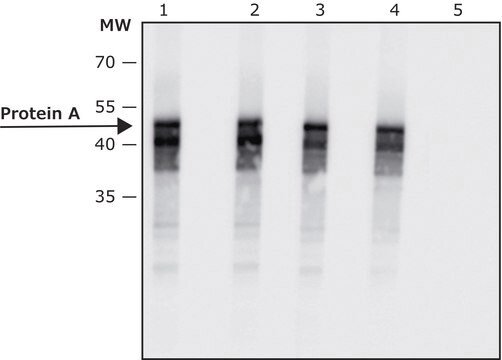Alle Fotos(1)
Wichtige Dokumente
P3775
Anti-Protein A antibody produced in rabbit
fractionated antiserum, lyophilized powder
Synonym(e):
Anti-Protein A
Anmeldenzur Ansicht organisationsspezifischer und vertraglich vereinbarter Preise
Alle Fotos(1)
About This Item
Empfohlene Produkte
Biologische Quelle
rabbit
Qualitätsniveau
Konjugat
unconjugated
Antikörperform
fractionated antiserum
Antikörper-Produkttyp
primary antibodies
Klon
polyclonal
Form
lyophilized powder
Verpackung
vial of 2 mL lyophilized antiserum
Methode(n)
indirect ELISA: 1:100,000
Lagertemp.
2-8°C
Posttranslationale Modifikation Target
unmodified
Verwandte Kategorien
Allgemeine Beschreibung
Protein A is a 42 kDa bacterial protein. It is isolated from the cell wall of Staphylococcus aureus.
The fractionation procedure yields primarily the immunoglobulin fraction of antiserum. To ensure specificity the fractionated antiserum is adsorbed using solid phase techniques, if necessary. Rabbit Anti-Protein A is lyophilized from 0.01 M phosphate buffered saline, pH 7.2, to which no preservatives have been added. Identity and purity of the antibody is established by immunoelectrophoresis. Electrophoresis of the antibody preparation followed by diffusion versus anti-rabbit IgG results in a single arc of precipitation and versus anti-rabbit whole serum results in multiple arcs of precipitation.
Immunogen
Protein A from Staphylococcus aureus
Anwendung
Anti-Protein A antibody produced in rabbit has been used in immunoblotting.
Protein A may be used as in immunoblotting with a minimum dilution of 1:50,000.
Biochem./physiol. Wirkung
Protein A has an ability to bind Fc region of immunoglobulins from several species. It is used as a “universal tracer” and it facilitate the segregation of bound and free ligand. Protein A also acts as affinity matrices for antibody (IgG) purification.
Physikalische Form
Lyophilized from 0.01M phosphate buffered saline, pH 7.2
Rekonstituierung
Reconstitute with 2 ml deionized water.
Haftungsausschluss
Unless otherwise stated in our catalog or other company documentation accompanying the product(s), our products are intended for research use only and are not to be used for any other purpose, which includes but is not limited to, unauthorized commercial uses, in vitro diagnostic uses, ex vivo or in vivo therapeutic uses or any type of consumption or application to humans or animals.
Sie haben nicht das passende Produkt gefunden?
Probieren Sie unser Produkt-Auswahlhilfe. aus.
Kontrolle
Produkt-Nr.
Beschreibung
Preisangaben
Lagerklassenschlüssel
11 - Combustible Solids
WGK
WGK 3
Flammpunkt (°F)
Not applicable
Flammpunkt (°C)
Not applicable
Persönliche Schutzausrüstung
Eyeshields, Gloves, type N95 (US)
Hier finden Sie alle aktuellen Versionen:
Besitzen Sie dieses Produkt bereits?
In der Dokumentenbibliothek finden Sie die Dokumentation zu den Produkten, die Sie kürzlich erworben haben.
Kunden haben sich ebenfalls angesehen
Human IgG subclasses
Antibody Fc, 159-177 (2014)
Smriti Kala et al.
PloS one, 7(10), e46864-e46864 (2012-10-12)
Most mitochondrial mRNAs in trypanosomatid parasites require uridine insertion/deletion RNA editing, a process mediated by guide RNA (gRNA) and catalyzed by multi-protein complexes called editosomes. The six oligonucleotide/oligosaccharide binding (OB)-fold proteins (KREPA1-A6), are a part of the common core of
Jitendra Thakur et al.
Eukaryotic cell, 10(10), 1295-1305 (2011-05-17)
A fungus-specific outer kinetochore complex, the Dam1 complex, is essential in Saccharomyces cerevisiae, nonessential in fission yeast, and absent from metazoans. The reason for the reductive evolution of the functionality of this complex remains unknown. Both Candida albicans and Schizosaccharomyces
IMMUNOASSAY CONFIGURATIONS
Immunoassay (1996)
Cell cycle-dependent phosphorylation and ubiquitination of a G protein alpha subunit
Torres MP, et al.
The Journal of Biological Chemistry, 286(23), 20208-20216 (2011)
Unser Team von Wissenschaftlern verfügt über Erfahrung in allen Forschungsbereichen einschließlich Life Science, Materialwissenschaften, chemischer Synthese, Chromatographie, Analytik und vielen mehr..
Setzen Sie sich mit dem technischen Dienst in Verbindung.













